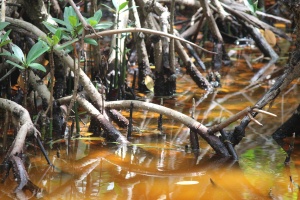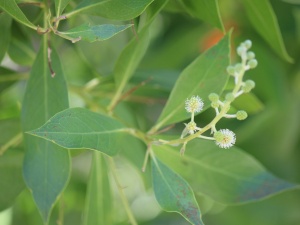
…or pantry, or “eyesore that needs to be whacked weekly with a LOUD polluting device”, depending on your perspective.


Storms over the last couple of years have brought dramatic change to the plant community along the northern fence. The original idea was to flex against the neighbor’s whack-a-mole wall o’ privet (Ligustrum sinense) with a mostly edible buffer of yaupon (Ilex vomitoria), blueberries (Vaccinium spp./cultivars), winged sumac (Rhus copallina)

chickasaw plum (Prunus angustifolia), Eastern mayhaw (Crataegus aestivalis), muscadine/scuppernong (Muscadinia rotundifolia) and a ground layer of wild strawberry (Fragaria virginicia). This worked rather well until Florence used the neighbor’s trees to flatten the entire assemblage. The neighbor’s privet rebounded with great enthusiasm within weeks, but it has taken a couple of years for the fruit buffer to recover. In the meantime, a new group of plants has colonized the newly-sunny gaps – outcompeting pernicious privet seedlings – and IT HAS BEEN JUST AWESOME FOR BUGS AND BIRDS!




Earlier in the year, dewberry (Rubus flagellaris) took advantage of the real estate, along with some Venus’ looking-glass (Triodanis perfoliata), and new beautyberry seedlings (Callicarpa americana). American pokeweed (Phytolacca americana), the frenemy/‘sallat’ of olden days, also arrived, and St. Andrew’s cross (Hypericum hypericoides) is increasing. It wouldn’t be SE NC without edge-loving jackson-vine (Smilax smallii), catbriar (Smilax bona-nox), Virginia creeper (Parthenocissus cinquefolia), yellow passionflower (Passiflora lutea) and creeping cucumber (Melothria pendula).

Now that fall is here, members of the aster family are taking charge, mostly featuring Spanish needles (Bidens bipinnata), dogfennel (Eupatorium capillifolium) and horseweed (Conyza canadensis). See banner photo!


All this to share that we’ve never seen such variety and quantity in the birds, in every month of this crazy year, each finding something useful and/or comforting in the various layers of shelter, food, nesting. It’s mind-boggling, and so much fun to observe. Now if this lovely buffer could only cancel out the relentless mowing and blowing on the other side…











